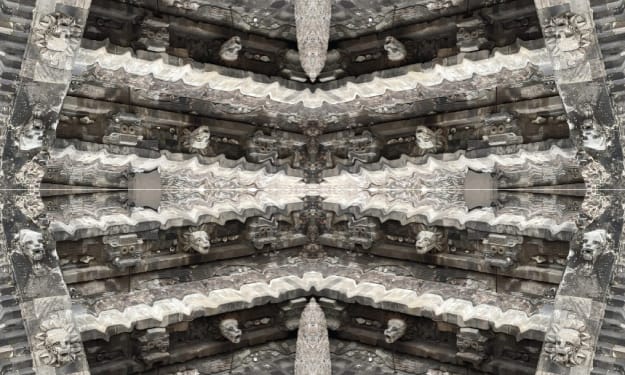What's inside the Statue of Liberty?
Statue of Liberty

Let's take a look inside the Statue of Liberty. Let's quickly go through the history of how the statue was built and where you can enter. The official name of the statue is Liberty Enlightening the World, but today it is known as the Statue of Liberty. It was a gift from the French to the United States in 1886. If we zoom in on Europe, here is France, and across the ocean is the United States. The Statue of Liberty is here on the east coast. If we zoom in on it, you can see the state of New York and the state of New Jersey. Between these two states lies the Upper Bay, often referred to as New York Harbor. The Statue of Liberty is here on Liberty Island. And if we zoom out again, you can see Manhattan with all the famous New York buildings. Here is Governor's Island, another popular tourist destination, and here is Ellis Island, where many immigrants arrived in the United States between 1892 and 1954. When the boats pulled into the harbor, the Statue of Liberty was one of the first sights that immigrants saw. Coming to the United States. The Statue of Liberty has become known as a symbol of freedom. In his right hand, he holds a torch, and in his left, a tablet bearing the date of the Declaration of Independence in Roman numerals. One thing you can't see from the ground are the broken shackles and chain. Its purpose is to symbolize the end of slavery. The statue is 46 meters high. If you count from the beginning, it is 93 meters high. It is about as tall as a 20-story building. Here, the size of a person is compared to the figure's big toe. When it was completed in 1886, it was the tallest statue in the world, but the Statue of Unity of India now holds the title. The Statue of Liberty is made of copper. That's right; originally, it was the color of a penny. It only took about 20 years for the air and rain to slowly oxidize and turn metallic green. The copper metal is only 2.4 millimeters thick. That's less than two US cents. The statue was built in pieces, and a statue this big requires a lot of planning. The statue was designed by the French sculptor Frederic August Bartholdi. First, he made an original clay sculpture. It was only 1.2 meters high. The average adult is slightly taller than that. The next larger version would be twice as large and made of plaster. The next version would be much bigger. This is 1/4 the size of the entire figure. At each stage of expansion, the details of Berthold's form could be further refined. For the full-size version, it had to be built in pieces to fit in the workshop. At one point, a finished version of the statue's head was presented in France, and the right arm and torch were presented in the United States to raise funds.
Visitors can pay to climb to the top of all of them. So how do you get from the plaster model of the statue to the finished copper version? The final version was made of copper plates. They used a method called repousse. This is how it works. They took full-sized pieces of plaster from the statue and built a wooden form next to it. This would then be used to form copper pieces. They hammer them into place until they match the shape of the wooden mold. After that, the copper was supported from the inside with iron straps. Now we have a finished piece of the Statue of Liberty. These pieces, by themselves, would never support their own weight. It needs a supporting structure and was designed by Gustave Eiffel. His name may sound familiar. Just a few years later, he helped build the Eiffel Tower in Paris, France. In the Centre of the Statue of Liberty is an iron pillar. It can be considered the backbone of the Statue of Liberty. Smaller support beams were then built around it to support the copper pieces of the statue. The structure would allow the statue to sway in the wind up to 12 centimeters at the top. It was all first built in Paris, France, and took almost 10 years to build. Then, when it was finished, it was disassembled into 350 different parts. All of it was shipped across the ocean to the United States. It took another four months to assemble the statue on the stand. The French paid for the statue, but the United States paid for the pedestal. When the statue was completed in 1886, it was called Bedloe's Island, but today we call it Liberty Island. The Statue of Liberty has been slightly renovated over the years. One of those renovations was a flashlight. It was damaged and leaking rainwater. It was replaced in the 1980s. The original flashlight is still on the screen. You have to take a ferry to get to Liberty Island unless you are a very good swimmer, but I don't recommend it. The ferry departs from two locations: Liberty State Park in New Jersey and the Battery at the southern tip of Manhattan. It takes about 15 minutes to get to Liberty Island. The area of the island is a little less than 15 hectares. This is Flagpole Plaza, an information Centre, café, bookstore, and gift shop. This is the Museum of the Statue of Liberty. It opened in 2019, so it's still pretty new. We follow this path to reach the statue. There are many places to walk here.
This allows you to view the shape from any angle you choose. The bottom of the shape looks like a star. This is the remains of an old military base called Fort Wood. It was used in the early 19th century but is now the base of the Statue of Liberty. This part is called the base. If you buy a plinth ticket, you can go anywhere from the top of the plinth of the statue up to the observation deck. If you want to enter the statue, you have to buy a ticket to go to the crown. Getting one of these tickets is a bit more complicated. In general, you should book a few weeks or even a month in advance. You can still go to the island after the pandemic, but the public is not allowed on any part of the plinth or statue. Hopefully, that will change soon. To enter the statue, let's enter here. These doors are called Centennial Doors. Please note that you must have a standing ticket to enter. Enter here to access the pedestal lobby. The original torch of the Statue of Liberty was located here in the Centre. When the museum opened in 2019, the torch was moved there. So now the pedestal lobby is open again. There used to be an old museum here in this area, but now most of everything has been moved to the new museum. Now it's time to climb to the top of the pedestal. You have two options. The elevator is here, or the stairs are here. There are 192 steps to the top of the pedestal. Here, you can see the stairs going up and the stairs going down on the other side. There are seven layers inside the stand. So it's 1P, 2P, and up to 7P, the top one. On the 3P level, you can go outside and look at the surrounding areas, and on the 6P level, there is a formal viewing platform.
You can exit either here or here. Once outside, you get a good 360-degree view of every port. If you have a ticket to the crown, go to level 7P. This is where you begin your climb to the top of the statue. It's called the Double Helix Staircase, one way up and one way back down. These stairs fit right into the middle of the support structure. There is not much space here, and I hope you are not afraid of heights. If you get tired, there are a few places to rest. And just to be sure, there is also an emergency elevator inside the statue, not for normal public use. It can accommodate only three people and can stop a few levels down the spiral staircase. As you climb, you can see the metal frame holding the statue. You can even see the individual ripples of the figure's dress. And finally, we reach the top of the spiral staircase. This area is called the crown. Only a limited number of people can stay here at a time. It's a great place to look out over the harbor from the windows. There are a total of 25 windows in the crown. Inside, you can even see the figure's individual hair patterns. In the back, you'll also notice some lights that turn on at night. Once you're done here, you can start your way down the other side of the double helix staircase. Many people ask about the flashlight. In 1916, an explosion in New York Harbor damaged the statue. Since then, they have never reopened the torch to the public. However, maintenance workers sometimes have to climb into the flashlight. Right in the neck of the statue is a gate that gives access to the arm. When you come here, there is a long ladder at the end of your hand. It's not the easiest climb. Then there is another ladder, and at the top is a small door that opens to fresh air. So hopefully the COVID restrictions will be eased and visits will again be allowed inside the statue.
About the Creator
Durga Prasad
My "spare" time is spent creating for myself and writing for others.
Enjoyed the story? Support the Creator.
Subscribe for free to receive all their stories in your feed. You could also pledge your support or give them a one-off tip, letting them know you appreciate their work.





Comments
There are no comments for this story
Be the first to respond and start the conversation.